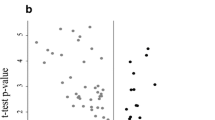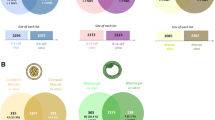Abstract
Spontaneous in vitro hatching of human blastocysts starts with the formation of a tunnel through the zona pellucida (ZP) by cellular projections of trophoblast cells. Our aim was to identify the proteins that are upregulated in these initially hatching cells as compared to trophectoderm (TE) cells from blastocysts that had not yet hatched. Forty seven women that underwent assisted reproduction treatment donated their ICSI-derived polyploid blastocysts for the study. In polyploid blastocysts that started spontaneous hatching, hatched clusters of cells were collected from the outer side of the ZP. Liquid chromatography mass spectrometry was applied to determine the proteins that were upregulated in these cells as compared to TE cells obtained from inside the ZP. Whole non-hatched polyploid blastocysts were used as controls. Overall 1245 proteins were identified in all samples. Forty nine proteins were significantly upregulated in hatching cells and 17 in the TE cells. There was minimal overlap between hatching and TE samples; only serine protease inhibitors (SERPINS) and lipocalin were detected in both samples. Myosin and actin were highly upregulated in the hatching cells as well as paraoxonase, N-acetylmuramoyl alanine amidase, and SERPINS clade A and galectin. In the TE cells, gamma butyrobetaine dioxygenase, lupus La protein, sialidase, lysosomal Pro-X carboxypeptidase, phospholipase b, and SERPINS clade B and A were among the most highly upregulated proteins. These findings may contribute to the basic knowledge of the molecular behavior of the specific cells that actively perforate the glycoprotein matrix of the ZP.


Similar content being viewed by others
References
Aitken RJ, Flanagan HM, Connaughton H, Whiting S, Hedges A, Baker MA (2016) Involvement of homocysteine, homocysteine thiolactone, and paraoxonase type 1 (PON-1) in the etiology of defective human sperm function. Andrology 2:345–360
Altmäe S, Reimand J, Hovatta O, Zhang P, Kere J, Laisk T, Saare M, Peters M, Vilo J, Stavreus-Evers A, Salumets A (2012) Research resource: interactome of human embryo implantation: identification of gene expression pathways, regulation, and integrated regulatory networks. Mol Endocrinol 26:203–217
Araki Y, Matsui Y, Iuzumi A, Tsuchiyta S, Kaneko Y, Sato K, Ozaki T, Araki Y, Nishimura M (2016) Effect of the presence of trophectoderm vesicles on blastocyst in relation to in vitro hatching, clinical pregnancy, and miscarriage rates. Hum Cell 29:176–180
Barriento G, Freitag N, Tirado-González I, Unverdorben L, Jeschke U, Thijssen VL, Blois SM (2014) Involvement of galectin-1 in reproduction: past, present and future. Hum Reprod Update 20:75–93
Browne RW, Shelly WB, Bloom MS, Ocque AJ, Sandler JR, Huddleston HG, Fujimoto VY (2008) Distributions of high-density lipoprotein particle components in human follicular fluid and sera and their associations with embryo morphology parameters during IVF. Hum Reprod 23:1884–1894
Clark GF (2013) The role of carbohydrate recognition during human sperm-egg binding. Hum Reprod 28:566–577
Cox J, Hein MY, Luber CA, Paron I, Nagaraj N, Mann M (2014) Accurate proteome-wide label-free quantification by delayed normalization and maximal peptide ratio extraction, termed MaxLFQ. Mol Cell Proteomics 13:2513–2526
Dunning KR, Cashman K, Russell DL, Thompson JG, Norman RJ, Robker RL (2010) Beta-oxidation is essential for mouse oocyte developmental competence and early embryo development. Biol Reprod 83:909–918
Elinger D, Gabashvili A, Levin Y (2019) Suspension trapping (S-Trap) is compatible with typical protein extraction buffers and detergents for bottom-up proteomics. J Proteome Res 18:1441–1445
Furlong CE, Suzuki SM, Stevens RC, Marsillach J, Richter RJ, Jarvik GP, Checkoway H, Samii A, Costa LG, Griffith A, Roberts JW, Yearout D, Zabetian CP (2010) Human PON1, a biomarker of risk of disease and exposure. Chem Biol Interact 87:355–361
Hardarson T, Van Landuyt L, Jones G (2012) The blastocyst. Hum Reprod 27(Suppl 1):i72–i91
Heit C, Jackson BC, McAndrews M, Wright MW, Thompson DC, Silverman GA, Nebert DW, Vasiliou V (2013) Update of the human and mouse SERPIN gene superfamily. Hum Genomics 7:22–36
Iwasawa T, Takahashi K, Goto M, Anzai M, Hiromitsu S, Sato W, Kumazawa Y, Terada Y (2019) Human frozen-thawed blastocyst morphokinetics observed using time-lapse cinematography reflects the number of trophectoderm cells. PLOS ONE 14:e0210992
Kaihola H, Yaldir FG, Bohlin T, Samir R, Hreinsson J, Åkerud H (2019) Levels of caspase-3 and histidine-rich glycoprotein in the embryo secretome as biomarkers of good-quality day-2 embryos and high-quality blastocysts. PLOS ONE 14(12):e0226419
Kim MK, Park JK, Paek SK, Kim JW, Kwak IP, Lee HJ, Lyu SW, Lee WS (2018) Effects and pregnancy outcomes of L-carnitine supplementation in culture media for human embryo development from in vitro fertilization. Obstet Gynaecol Res 44:2059–2066
Kirkegaard K, Hindkjaer JJ, Ingerslev HJ (2013) Hatching of in vitro fertilized human embryos is influenced by fertilization method. Fertil Steril 100:1277–1282
Lucas A, Yaron JR, Zhang L, Ambadapadi S (2018) Overview of Serpins and their roles in biological systems. Methods Mol Biol 1826:1–7
McReynolds S, Vanderlinden L, Stevens J, Hansen K, Schoolcraft WB, Katz-Jaffe MG (2011) Lipocalin-1: a potential marker for noninvasive aneuploidy screening. Fertil Steril 95:2631–2633
Nordqvist S, Kårehed K, Hambiliki F, Wånggren K, Stavreus-Evers A, Akerud H (2010) The presence of histidine-rich glycoprotein in the female reproductive tract and in embryos. Reprod Sci 7:941–947
Park JM, Kohn MJ, Bruinsma MW, Vech C, Intine RV, Fuhrmann S, Grinberg A, Mukherjee I, Love PE, Ko MS, DePamphilis ML, Maraia RJ (2006) The multifunctional RNA-binding protein La is required for mouse development and for the establishment of embryonic stem cells. Mol Cell Biol 26:1445–1451
Sathananthan H, Menezes J, Gunasheela S (2003) Mechanics of human blastocyst hatching in vitro. Reprod BioMed Online 7:228–234
Seshagiri PB, Vani V, Madhulika P (2016) Cytokines and blastocyst hatching. Am J Reprod Immunol 75:208–217
Tirado-González I, Freitag N, Barrientos G, Shaikly V, Nagaeva O, Strand M, Kjellberg L, Klapp BF, Mincheva-Nilsson L, Cohen M, Blois SM (2013) Galectin-1 influences trophoblast immune evasion and emerges as a predictive factor for the outcome of pregnancy. Mol Hum Reprod 19:43–53
Wang J, Matafonov A, Madkhali H, Mahdi F, Watson D, Schmaier AH, Gailani D, Shariat-Madar Z (2014) Prolylcarboxypeptidase independently activates plasma prekallikrein (fletcher factor). Curr Mol Med 14:1173–1185
Author information
Authors and Affiliations
Corresponding author
Additional information
Editor: Tetsuji Okamoto
Miriam Almagor and Yishai Levin should be considered similar in author order
Rights and permissions
About this article
Cite this article
Almagor, M., Levin, Y., Halevy Amiran, R. et al. Spontaneous in vitro hatching of the human blastocyst: the proteomics of initially hatching cells. In Vitro Cell.Dev.Biol.-Animal 56, 859–865 (2020). https://doi.org/10.1007/s11626-020-00522-w
Received:
Accepted:
Published:
Issue Date:
DOI: https://doi.org/10.1007/s11626-020-00522-w




